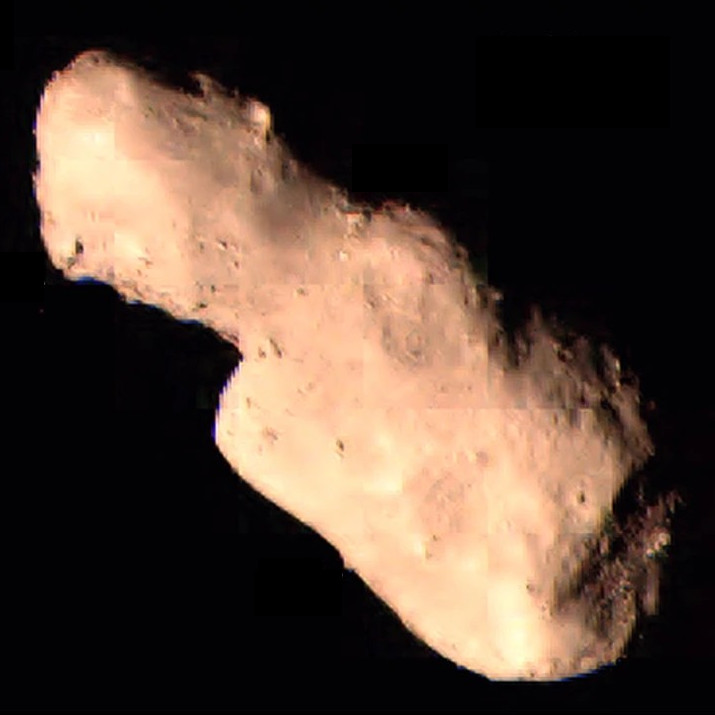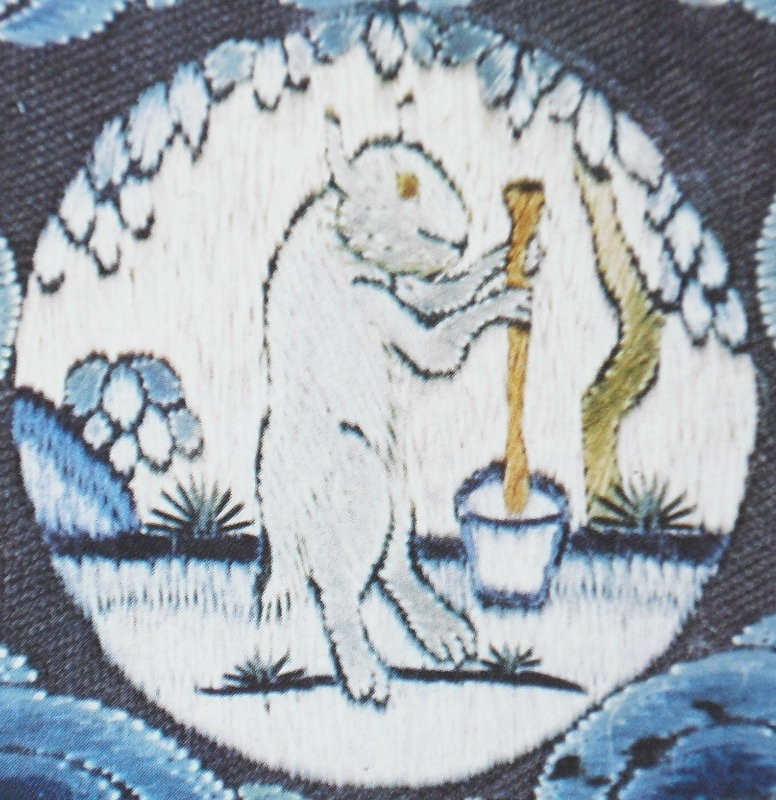|
Chang'e 4
Chang'e 4 (; ) is a robotic spacecraft mission in the Chinese Lunar Exploration Program of the CNSA. It made a soft landing on the far side of the Moon, the first spacecraft to do so, on 3 January 2019. A communication relay satellite, , was first launched to a halo orbit near the Earth–Moon L2 point in May 2018. The robotic lander and '' Yutu-2'' () rover were launched on 7 December 2018 and entered lunar orbit on 12 December 2018, before landing on the Moon's far side. On 15 January it was announced that seeds had sprouted in the lunar lander's biological experiment, the first plants to sprout on the Moon. The mission is the follow-up to Chang'e 3, the first Chinese landing on the Moon. The spacecraft was originally built as a backup for Chang'e 3 and became available after Chang'e 3 landed successfully in 2013. The configuration of Chang'e 4 was adjusted to meet new scientific and performance objectives. Like its predecessors, the mission is named after Chang'e, ... [...More Info...] [...Related Items...] OR: [Wikipedia] [Google] [Baidu] |
Yutu-2
''Yutu-2'' () is the robotic lunar rover component of China National Space Administration, CNSA's Chang'e 4 mission to the Moon, launched on 7 December 2018 18:23 UTC, it entered lunar orbit on 12 December 2018 before making the first soft landing on the far side of the Moon on 3 January 2019. ''Yutu-2'' is currently operational as the longest-lived lunar rover after it eclipsed (on 20 November 2019) the previous lunar longevity record of 321 Earth days held by Soviet Union's ''Lunokhod 1'' rover. ''Yutu-2'' is the first lunar rover to traverse the far side of the Moon. By January 2022, it had travelled a distance of more than along the lunar surface. Data from its ground penetrating radar (GPR) has been used by scientists to put together imagery of multiple layers deep beneath the surface of the far side of the Moon. As of September 2024, the ''Yutu-2'' was still active. Overview The total landing mass is . Both the stationary lander and ''Yutu-2'' rover (literally: "Moon r ... [...More Info...] [...Related Items...] OR: [Wikipedia] [Google] [Baidu] |
Far Side Of The Moon
The far side of the Moon is the hemisphere of the Moon that is facing away from Earth, the opposite hemisphere is the near side. It always has the same surface oriented away from Earth because of synchronous rotation in the Moon's orbit. Compared to the near side, the far side's terrain is rugged, with a multitude of impact craters and relatively few flat and dark lunar maria ("seas"), giving it an appearance closer to other barren places in the Solar System such as Mercury and Callisto. It has one of the largest craters in the Solar System, the South Pole–Aitken basin. The hemisphere has sometimes been called the "Dark side of the Moon", where "dark" means "unknown" instead of "lacking sunlight" each location on the Moon experiences two weeks of sunlight while the opposite location experiences night. About 18 percent of the far side is occasionally visible from Earth due to oscillation and to libration. The remaining 82 percent remained unobserved until 1959, when ... [...More Info...] [...Related Items...] OR: [Wikipedia] [Google] [Baidu] |
Chang'e 6
Chang'e 6 () was the sixth robotic lunar exploration mission by the China National Space Administration (CNSA) and the second CNSA lunar sample-return mission. Like its predecessors in the Chinese Lunar Exploration Program, the spacecraft is named after the Chinese moon goddess Chang'e. It was the first lunar mission to retrieve samples from the far side of the Moon; all previous samples were collected from the near side. The mission began on 3 May 2024 when the spacecraft was launched from Wenchang Space Launch Site on Hainan Island. Its lander and rover touched down on the lunar far side on 1 June 2024. The lander's robotic scoop and drill took samples with a total mass of 1935.3 grams from the lunar surface; the ascender module then carried these into lunar orbit on 3 June 2024. The ascender docked with the orbiter module in lunar orbit on 6 June 2024 and transferred the samples to an atmospheric re-entry module which then returned to Earth. The mission's lander and ... [...More Info...] [...Related Items...] OR: [Wikipedia] [Google] [Baidu] |
Chang'e 2
Chang'e 2 (; ) is a Chinese uncrewed lunar probe that was launched on 1 October 2010. It was a follow-up to the Chang'e 1 lunar probe, which was launched in 2007. Chang'e 2 was part of the first phase of the Chinese Lunar Exploration Program, and conducted research from a 100-km-high lunar orbit in preparation for the December 2013 soft landing by the Chang'e 3 lander and rover. Chang'e 2 was similar in design to Chang'e 1, although it featured some technical improvements, including a more advanced onboard camera. Like its predecessor, the probe was named after Chang'e, an ancient Chinese moon goddess. After completing its primary objective, the probe left lunar orbit for the Earth–Sun Lagrangian point, to test the Chinese tracking and control network, making the China National Space Administration the third space agency after NASA and ESA to have visited this point. It entered orbit around L2 on 25 August 2011, and began transmitting data from its new position in Septem ... [...More Info...] [...Related Items...] OR: [Wikipedia] [Google] [Baidu] |
International Astronautical Federation
The International Astronautical Federation (IAF) is an international space advocacy organization based in Paris, and founded in 1951 as a non-governmental organization to establish a dialogue between scientists around the world and to lay the information for international space cooperation. It has over 390 members from 68 countries across the world. They are drawn from space agencies, companies, universities, professional associations, museums, government organizations and learned societies. The IAF organizes the annual International Astronautical Congress (IAC). Pascale Ehrenfreund has served as the president of the IAF. History After World War II, Heinz Gartmann, Gunter Loeser, and Heinz-Hermann Koelle formed the German Rocket Society. They contacted the British Interplanetary Society (BIS) and Groupement Astronautique Français. The French group's leader, Alexandre Ananoff, organized the First International Congress for Astronautics in Paris, France, in September ... [...More Info...] [...Related Items...] OR: [Wikipedia] [Google] [Baidu] |
Royal Aeronautical Society
The Royal Aeronautical Society, also known as the RAeS, is a British multi-disciplinary professional institution dedicated to the global aerospace community. Founded in 1866, it is the oldest Aeronautics, aeronautical society in the world. Members, Fellows, and Companions of the society can use the post-nominal letters MRAeS, FRAeS, or CRAeS, respectively. Function The objectives of The Royal Aeronautical Society include: to support and maintain high professional standards in aerospace disciplines; to provide a unique source of specialist information and a local forum for the exchange of ideas; and to exert influence in the interests of aerospace in the public and industrial arenas, including universities. The Royal Aeronautical Society is a worldwide society with an international network of 67 branches. Many practitioners of aerospace disciplines use the Society's designatory Post-nominal letters, post-nominals such aFRAeS CRAeS, MRAeS, AMRAeS, and ARAeS (incorporating the fo ... [...More Info...] [...Related Items...] OR: [Wikipedia] [Google] [Baidu] |
Moon Goddess
A lunar deity or moon deity is a deity who represents the Moon, or an aspect of it. These deities can have a variety of functions and traditions depending upon the culture, but they are often related. Lunar deities and Moon worship can be found throughout most of recorded history in various forms. Moon in religion and mythology Many cultures have implicitly linked the 29.5-day lunar cycle to women's menstrual cycles, as evident in the shared linguistic roots of "menstruation" and "moon" words in multiple language families. This identification was not universal, as demonstrated by the fact that not all moon deities are female. Still, many well-known mythologies feature moon goddesses, including the Greek goddess Selene, the Roman goddess Luna, the Chinese goddess Chang'e, and the Mayan goddess Coyolxauhqu, who's decapitation may represent a lunar eclipse. Several goddesses including Artemis, Hecate, and Isis did not originally have lunar aspects, and only acquired them late ... [...More Info...] [...Related Items...] OR: [Wikipedia] [Google] [Baidu] |
Business Insider
''Business Insider'' (stylized in all caps: BUSINESS INSIDER; known from 2021 to 2023 as INSIDER) is a New York City–based multinational financial and business news website founded in 2007. Since 2015, a majority stake in ''Business Insider''s parent company Insider Inc. has been owned by the international publishing house Axel Springer. It operates several international editions, including one in the United Kingdom. ''Insider'' publishes original reporting and aggregates material from other outlets. it maintained a liberal policy on the use of anonymous sources. It has also published native advertising and granted sponsors editorial control of its content. The outlet has been nominated for several awards, but has also been criticized for using factually incorrect clickbait headlines to attract viewership. In 2015, Axel Springer SE acquired 88 percent of the stake in Insider Inc. for $343 million (€306 million), implying a total valuation of $442 million. From ... [...More Info...] [...Related Items...] OR: [Wikipedia] [Google] [Baidu] |
Moon Rabbit
The Moon rabbit, Moon hare or Jade rabbit is a mythical figure in both East Asian and indigenous American folklore, based on interpretations that identify the lunar mare, dark markings on the near side of the Moon as a rabbit or hare. In East Asian mythology, the rabbit is seen as pounding with a mortar and pestle, but the contents of the mortar differ among Chinese, Japanese, Korean, and Vietnamese folklore. In Chinese folklore, the rabbit, Yutu, is often portrayed as a companion of the Moon goddess Chang'e, constantly pounding the elixir of life for her and some show the making of cakes or rice cakes; but in Japanese and Korean versions, the rabbit is pounding the ingredients for mochi or tteok or some other type of rice cakes; in the Vietnamese version, the Moon rabbit often appears with Hằng Nga and Chú Cuội, and like the Chinese version, the Vietnamese Moon rabbit also pounding the elixir of immortality in the mortar. In some Chinese versions, the rabbit pounds medicine ... [...More Info...] [...Related Items...] OR: [Wikipedia] [Google] [Baidu] |
Lunar Lander
A lunar lander or Moon lander is a Lander (spacecraft), spacecraft designed to Moon landing, land on the surface of the Moon. As of 2024, the Apollo Lunar Module is the only lunar lander to have ever been used in human spaceflight, completing six lunar landings from 1969 to 1972 during the United States, United States' Apollo program, Apollo Program. Several robotic landers have reached the surface, and some have returned Moon rock, samples to Earth. The design requirements for these landers depend on factors imposed by the payload, flight rate, propulsive requirements, and configuration constraints. Other important design factors include overall energy requirements, mission duration, the type of mission operations on the lunar surface, and life support system if crewed. The relatively high gravity (higher than all known asteroids, but lower than all Solar System planets) and lack of Atmosphere of the Moon, lunar atmosphere negates the use of aerobraking, so a lander must use pr ... [...More Info...] [...Related Items...] OR: [Wikipedia] [Google] [Baidu] |
Lagrangian Point
In celestial mechanics, the Lagrange points (; also Lagrangian points or libration points) are points of equilibrium (mechanics), equilibrium for small-mass objects under the gravity, gravitational influence of two massive orbit, orbiting bodies. Mathematically, this involves the solution of the restricted three-body problem. Normally, the two massive bodies exert an unbalanced gravitational force at a point, altering the orbit of whatever is at that point. At the Lagrange points, the gravitational forces of the two large bodies and the centrifugal force balance each other. This can make Lagrange points an excellent location for satellites, as Orbital station-keeping, orbit corrections, and hence fuel requirements, needed to maintain the desired orbit are kept at a minimum. For any combination of two orbital bodies, there are five Lagrange points, L1 to L5, all in the orbital plane of the two large bodies. There are five Lagrange points for the Sun–Earth system, and five ... [...More Info...] [...Related Items...] OR: [Wikipedia] [Google] [Baidu] |







